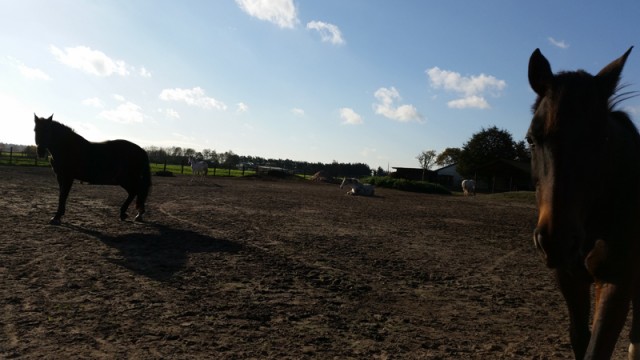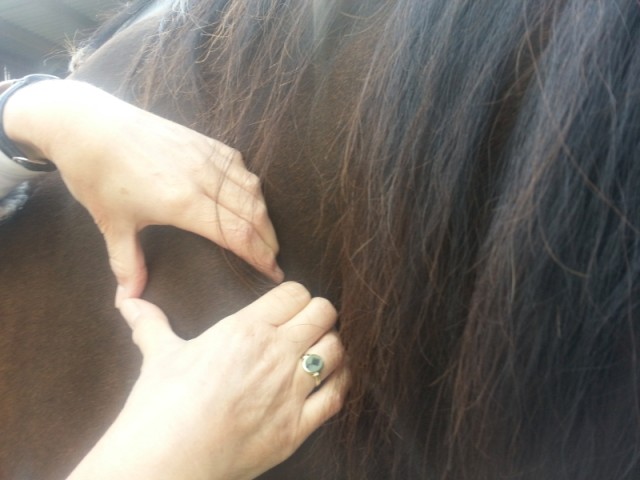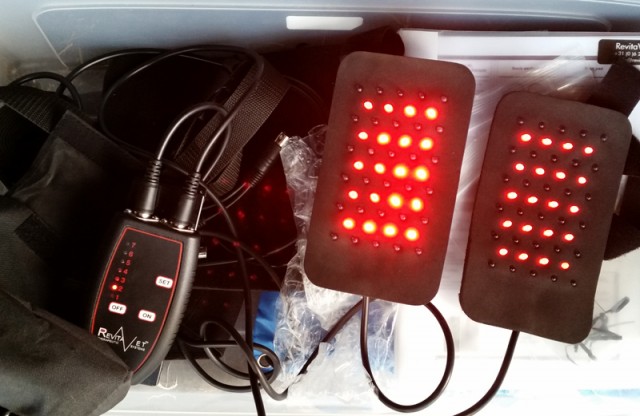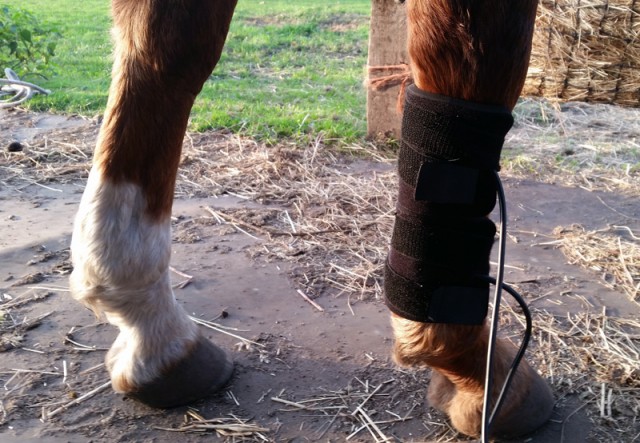 She stands in her small enclosure and stares out over the fence across the expanse of the sand paddock that separates her from the herd chomping hay from improvised slow feeders lining the opposite fence line, peering closely intent on capturing a glimpse of her equine mate. Anaïs, where are you? Why are you not standing here close to me? True, there is a fence between us but yet we can see, smell and even perhaps nuzzle each other gently through the gaps between the rails. But Anaïs has other priorities right now. There is a fresh pile of hay beneath her muzzle and it is proving to be quite a challenge to wrestle it through the mesh of the grid that covers it. This is something she must do for, as every orphan knows, there may be no hay after this. Her friend, Pip, will simply have to wait until she gets on the outside of the pile in front of her.
She stands in her small enclosure and stares out over the fence across the expanse of the sand paddock that separates her from the herd chomping hay from improvised slow feeders lining the opposite fence line, peering closely intent on capturing a glimpse of her equine mate. Anaïs, where are you? Why are you not standing here close to me? True, there is a fence between us but yet we can see, smell and even perhaps nuzzle each other gently through the gaps between the rails. But Anaïs has other priorities right now. There is a fresh pile of hay beneath her muzzle and it is proving to be quite a challenge to wrestle it through the mesh of the grid that covers it. This is something she must do for, as every orphan knows, there may be no hay after this. Her friend, Pip, will simply have to wait until she gets on the outside of the pile in front of her.
Independent Pip
As I arrive, she spies me walking down the narrow path towards her. She inclines her head towards me, the truncated, narrow blaze adorning the lower part of her face sharply contrasting with the liver chestnut of her coat, and nickers a welcome. If Anaïs will not come, perhaps this human will suffice for however long he may choose to stay.
It has been almost a month now since Pip has been diagnosed with a tendon injury and she has been isolated from the herd to the extent that she has not been able to move together with the other horses for six weeks or more. Initially, she found it difficult. She has had to draw and rely on her own resources, a prospect that would have launched her into panic two and a half years ago. Now she has more self-confidence, is a good deal more self-assured and is coping brilliantly.
There are still brief moments when she experiences the panic of abandonment. This occurs if she sees Vicki and I leaving with Anaïs or returning from a forest walk along the narrow country road which runs past her enclosure. Yet, once I take her out of her enclosure for her therapeutic walk along the road, she does not hesitate as she used to do in the past but accompanies me with an intensity that is comforting.
Thank you
In my last post I sent out a call for help and a number of you responded both in the form of comments on this blog and private emails. I would like to thank all of you for thinking of us and forwarding your suggestions.
Vicki and I have examined all of the potential remedies that you have suggested. They seem to have put us on the right track. I am particularly grateful to you for taking the time and making the effort to help Pip.
Touching the tender tendon
Don’t you just love the alliteration? It just rolls so nicely over the tongue. Initially, Pip’s tendon was rather warm and puffy, reflecting the images produced by the sonar scan, which revealed swelling and a pronounced presence of blood in the tissue.
Partly on the advice of our vet, Vicki and I have opted for a course of treatment which involves a multi-pronged approach. In the first place, I have placed restrictions on Pip’s movement. I have recently cordoned off half of her small enclosure, mainly to keep her out of deep mud caused by the autumn rains, leaving her with an area of approximately seven by four metres within which she can move. Unfortunately, this means that she can no longer touch the other horses. Fortunately, she can still communicate with them over an area of about three metres.
Secondly, I am trimming Pip’s hooves more regularly, especially the vulnerable right fore. It is important to keep the toe as short and the heels as high as possible to minimise the strain on the deep digital flexor tendon.
We have now also moved into a daily routine, which involves me first taking Pip for a therapeutic walk. We started off with a five-minute walk down the road towards the forest but are now up to ten minutes. Upon our return I allow her to graze on the side of the road, where the grass is still fairly thick on the ground. This is the only opportunity that she currently has to graze. A number of times a week I perform Equine Touch on her while she is grazing. My focus is on improving drainage and the blood flow.
In the red light district
A number of you suggested that we look into using red light therapy to help Pip. We did and have consequently moved into the red light district as it were. The product that we have opted for is called Revitavet. Whether or not it is superior to other products I cannot tell you. What convinced us to try it is that it is readily available in the Netherlands and the technology can be hired. It made sense to us to try it out first before considering the option of a purchase.
Red and infrared light therapy is not new. It has been around for at least forty years and its therapeutic benefits have been the subject of considerable research. Rather than try and replicate the extensive findings of that research here and thereby risk misrepresenting it, I feel it may be more beneficial to simply provide you with an online reference. A good place to start is the Revitavet website, which contains references to relevant scientific studies and commentaries here.
So every day I take Pip into a pen with a feed bin full of hay and attach two pads containing red LED light arrays to the lower leg covering both the tender part of the tendon and the area below it. I then set the controller to use three different frequencies for five minutes at a time. After fifteen minutes we are done and I take Pip back to her enclosure.
The results
Essentially, as I understand it, if the tendon is to be repaired, new cells need to be created. Given that the lifespan of a cell can amount to several months, no rocket science is involved to conclude that we are going to be some months down the track before we see any major signs of improvement in Pip’s tendon.
Nevertheless, it is interesting to note that after approximately four weeks of Equine Touch and about two and a half weeks of red light therapy, the puffiness has disappeared from Pip’s injured tendon, the area around it is cooler (partly thanks to the weather as we move towards winter), the swelling seems to have subsided slightly, more noticeably on the inside of the leg, and the contours of the leg are more clearly defined. In addition, Pip is walking out and there is no noticeable sign of lameness in the walk. Trotting is not something I want to see Pip doing at this point in time, as I have no doubt that she will be lame in the trot.
I cannot attribute these outcomes to any one particular treatment. What I can do is draw a conclusion to the effect that what we are doing seems to be making sense. In the first week of December I will be making another appointment with a vet to come out and conduct another sonar scan. This should give us a pretty good idea as to whether we are making progress.
Interaction with Pip
When Pip started out on the long road of convalescence, I started to toy with ideas for interaction with her which could be both interesting and useful to her, and beneficial for our relationship. There were a few times when I even tried out new things but Pip was not overly interested.
Rather than try and force the issue, I have let circumstances dictate the nature and extent of our interaction with each other. For the moment our focus is on just being together while Pip comes to terms with her new living conditions, receives treatment and has an opportunity to graze. To this extent we mainly just hang out with each other and I get plenty of opportunities to touch her body while performing Equine Touch. Whereas she could sometimes be so sensitive to the point of rejecting many Equine Touch moves in the past, Pip is now so much more at ease mentally and emotionally. I have also noticed that she is also physically far more relaxed and trusting. Indeed, there are some moves that she finds particularly pleasurable. For instance, she will allow me to lift her foreleg and perform an Equine Touch procedure over the knee or along the pectoral muscles between her foreleg’s and up the lower chest without being confined at all.
For the moment, Pip is still on the mend physically, mentally and emotionally. We seem to be enjoying each other’s company just being together. Seeing her so relaxed is a reward in itself. And for now it is enough.
Horses and Humans on Facebook
May I remind you that we now have a Horses and Humans group on Facebook. If you would like to leave a comment, you can do so on this blog or on the the Horses and Humans Facebook group page. All new posts will feature on that page along with additional content posted by any of our members. Please feel free to join us at:
https://www.facebook.com/groups/horsesandhumans/
There is also a Horses and Humans publications page, which contains information concerning the publications released under the Horses and Humans imprint. Some of those publications will be free of charge. You will find it here:
https://www.facebook.com/horsesandhumans
I also have a Facebook page through which you may contact me. You will find it at:
https://www.facebook.com/andrewglynsmail
Equine Touch
Vicki is operating two websites for Equine Touch at present. Listed as Humans for Horses, you can find the ordinary website at:
http://www.humansforhorses.com/
and the Facebook page at:
https://www.facebook.com/Humans.for.Horses









Hi Andrew,
Really does sound like you are on the right track correcting Pip’s injury, while reading you report a thought popped into my mind and that is Arnica which can be rubbed into the offending tendon and also can be taken internally as a homeopathic treatment, not sure of what the dosage would be for a horse though. Any Homeopathic Vets over that way, we have a couple here now, one not far from us and Wallsend and I know of one in Qld, maybe google them up and they would tell you the dosage.
Hi Laraine,
We have a great homeopathic vet we use. She prescribed Arnica and hopefully this is helping Pip as well. She also treats Anaiis occasionally, and each time we notice good improvement. I am lucky to have found a fantastic homeopathic doctor near us who has been helping me with some issues which popped up after a horse-related accident I had back in March. Homeopathy rocks!
Hi Andrew
Your sentence “We seem to be enjoying each other’s company just being together” struck a chord with me. Isn’t that something we humans repeatedly forget is so important, and often it takes situations like this to remind us of its value. We get so caught up in being “human-doings” (whether is with the goal of betterment for our horses, or pandering to our egos and human agendas) , that we forget to be “human-beings”.
Horses spend a lot of time together just being, but we always seems to be wanting to do/achieve something with them. Again, perhaps we need to remember to listen and learn from the horse.
May the journey to recovery, and the unexpected lessons learned in the process continue to steadily unfold for you both.
Smiles
Kell
http://www.waterfallcreek.com.au